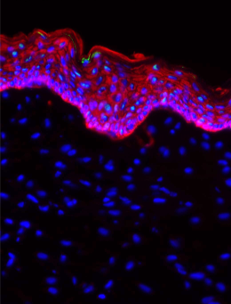A reconstructed human skin (RHS) is a laboratory-engineered model that mimics the structure and function of natural human skin. Composed of key cell types such as keratinocytes, melanocytes, and fibroblasts, these models replicate both the epidermal and dermal layers, allowing researchers to study skin biology in a controlled, reproducible environment. Unlike skin biopsies, which rely on tissue taken directly from a person, reconstructed skin is grown in vitro, often using donor cells cultured on specialized substrates to form a stratified, functional tissue.
In dermocosmetic research, reconstructed human skin plays a pivotal role. These models allow scientists to evaluate how skincare formulations affect skin barrier function, hydration, pigmentation, and inflammatory responses.
The precision and flexibility of reconstructed skin make it particularly valuable. Researchers can tailor models to include specific cell types or simulate pathological conditions such as acne, eczema, or photoaging.
This enables targeted testing and helps optimize formulations for different skin types and concerns.


